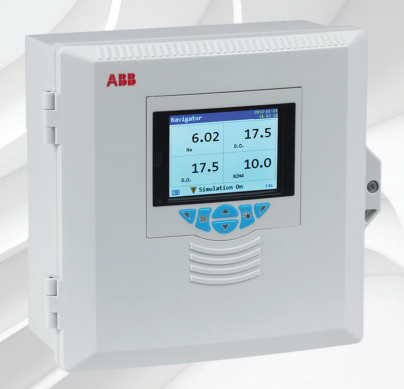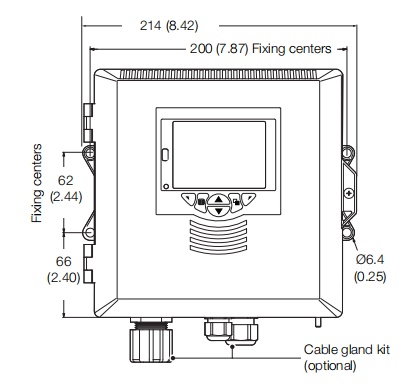

+086-15305925923
K-WANG
Service expert in industrial control field!
Product
Article
NameDescriptionContent
Adequate Inventory, Timely Service
pursuit of excellence


Ship control system
Equipment control system
Power monitoring system
Current position:
新闻动态
newS
Brand
ABB MEASUREMENT & ANALYTICS Navigator 540
ABB MEASUREMENT & ANALYTICS Navigator 540
ABB MEASUREMENT & ANALYTICS Navigator 540
Health & Safety
Safety precautions
Be sure to read, understand and follow the instructions contained within this manual before and during use of the equipment. Failure to do so
could result in bodily harm or damage to the equipment.
Potential safety hazards
Electrical
Safety standards
This product has been designed to satisfy the requirements of IEC61010-1:2010 3rd edition 'Safety Requirements for Electrical Equipment
for Measurement, Control and Laboratory Use' and complies with US NEC 500, NIST and OSHA.
Safety conventions
Warning. Installation, operation, maintenance and servicing must be performed:
by suitably trained personnel only
in accordance with the information provided in this manual
in accordance with relevant local regulations
Warning. To ensure safe use when operating this equipment, the following points must be observed:
Up to 240V AC may be present. Be sure to isolate the supply before removing the terminal cover.
Normal safety precautions must be taken to avoid the possibility of an accident occurring when operating in conditions of high
pressure and / or temperature.
Safety advice concerning the use of the equipment described in this manual or any relevant Material Safety Data Sheets (where
applicable) can be obtained from the Company, together with servicing and spares information.
Warning. In this manual, a warning is used to indicate a condition which, if not met, could cause serious personal injury and / or death.
Do not proceed beyond a warning until all conditions have been met.
Caution. A caution is used to indicate a condition which, if not met, could cause minor or moderate personal injury and / or damage to
the equipment. Do not proceed beyond a caution until all conditions have been met.
Note. A note is used to indicate important information or instructions that should be considered before operating the equipment.
Symbols
Symbols that appear on this product are shown below:
Product recycling and disposal (Europe only)
Restriction of Hazardous Substances (RoHS)
Specification
Electrical
Power supply ranges
100 to 240 V AC max., 50 / 60 Hz ± 10 %
(90 to 264 V AC, 45/65 Hz)
Power consumption
<10W
Terminal connections rating
AWG 26 to 16 (0.14 to 1.5 mm2)
Analog outputs
2 standard
2 optional
Galvanically isolated from the rest of the circuitry, 500 V for 1
minute. Range-programmable source and range 0 to 22 mA,
maximum load 750 @ 20 mA.
Relay outputs
4 standard
2 optional
Fully-programmable. Contacts rated at 5A @ 110 / 240 V. Standard
relays are changeover. Optional relays are normally closed (N/C).
Digital inputs / outputs
6 standard, user-programmable as input or output.
Minimum input pulse duration: 125 mS.
Input – volt-free or 24 V DC (conforms to IEC 61131-2).
Output – open-collector, 30 V, 100 mA max.
(conforms to IEC 61131-2).
Functional earth (ground) terminal.
Protective earth.
Alternating current supply only.
This symbol, when noted on a product, indicates a potential hazard which could cause serious personal injury and / or death.
The user should reference this instruction manual for operation and / or safety information.
This symbol, when noted on a product enclosure or barrier, indicates that a risk of electrical shock and / or electrocution exists
and indicates that only individuals qualified to work with hazardous voltages should open the enclosure or remove the barrier.
Recycle separately from general waste under the WEEE directive
Electrical equipment marked with this symbol may not be disposed of in European public disposal systems after 12 August
2005. To conform to European local and national regulations (EU Directive 2002/96/EC), European electrical equipment users
must now return old or end-of-life equipment to the manufacturer for disposal at no charge to the user.
ABB is committed to ensuring that the risk of any environmental damage or pollution caused by any of its products is minimized
as far as possible.
Note. For return for recycling, please contact the equipment manufacturer or supplier for instructions on how to return end-of-life
equipment for proper disposal.
The European Union RoHS Directive and subsequent regulations introduced in member states and other countries limits the
use of six hazardous substances used in the manufacturing of electrical and electronic equipment. Currently, monitoring and
control instruments do not fall within the scope of the RoHS Directive, however ABB has taken the decision to adopt the
recommendations in the Directive as the target for all future product design and component purchasing

Warning.
If the transmitter is used in a manner not specified by the Company, the protection provided by the equipment may be impaired.
Remove all power from supply, relay, any powered control circuits and high common mode voltages before accessing or making
any connections. Use cable appropriate for the load currents: 3-core cable rated 3 A and 75 °C (167 °F) minimum, and voltage:
100 / 240 V that conform to either IEC 60227 or IEC 60245, or to the National Electrical Code (NEC) for the US, or the Canadian
Electrical Code for Canada. The terminals accept cables AWG 26 to 16 (0.14 to 1.5 mm2).
Ensure the correct fuses are fitted – see Fig. 6 for fuse details.
Replacement of the internal battery must be carried out by an approved technician only.
The transmitter conforms to Installation Category II of IEC 61010.
All connections to secondary circuits must have insulation to required local safety standards. After installation, there must be no
access to live parts, for example, terminals. Use screened cable for signal inputs and relay connections. Route signal leads and
power cables separately, preferably in an earthed (grounded) flexible metal conduit.
All equipment connected to the transmitter's terminals must comply with local safety standards (IEC 60950, EN61010-1).
The ethernet and bus interface connectors must only be connected to SELV circuits.
USA and Canada Only
The supplied cable glands are provided for the connection of signal input and ethernet communication wiring ONLY.
The supplied cable glands and use of cable / flexible cord for connection of the mains power source to the mains input and relay
contact output terminals is not permitted in the USA or Canada.
For connection to mains (the mains input and relay contact outputs), use only suitably rated field wiring insulated copper
conductors rated min. 300 V, 16 AWG, 90C. Route wires through suitably rated flexible conduits and fittings.
Referring to Fig. 5:
1. Using a pozi-drive screwdriver, turn the (captive) electronics
section door retaining screw A 1/4 turn counter-clockwise
and open the door.
2. Turn the cover plate retaining screw B anti-clockwise until
the cover plate C can be removed.
3. Make connections to transmitter connection board terminals –
see Fig. 6.
4. Refit cover plate C and secure it by turning retaining screw
B clockwise until finger-tight. Close the door to the
electronics section and turn door retaining screw A 1/4 turn
clockwise to secure
- YOKOGAWA
- Energy Access
- Renewable Integration
- Energy Subsidies
- Energy and Water
- Net zero emission
- Energy Security
- Critical Minerals
- A-B
- petroleum
- Mine scale
- Energy and Gender
- Covid-19
- man-machine
- Reliance
- ADVANCED
- SEW
- ProSoft
- WATLOW
- Kongsberg
- FANUC
- VSD
- DCS
- PLC
- Sewage treatment
- cement
- Yaskawa
- Woodward
- BOSCH Rexroth
- MOOG
- General Electric
- American NI
- Rolls-Royce
- CTI
- Honeywell
- EMERSON
- Motorola
- xYCOM
- Automobile market
- architecture
- Industrial information
- New energy
- electricity
- Construction site
- HIMA
- ABB
- Rockwell
- Schneider Modicon
- Siemens
- MAN
- GE
- TRICONEX
- Control Wave
- ALSTOM
51
-
GE FANUC - IC693BEM340 High-Speed Ethernet Controller Module
-
GE DS200SDCIG2AGB - Advanced DC Power Supply & Instrumentation Board for Industrial Control
-
GE FANUC - IC693CHS397E CPU Base Advanced Control Module for Industrial Automation
-
GE UR7BH - Relay Module High Performance Relay for Industrial Control Applications
-
GE FANUC - A17B-3301-0106 CPU MODULE
-
GE Fanuc - HE693ADC415E Drive Module
-
GE IS200VAICH1D - Analog Input Module for Industrial Control Solutions
-
GE Fanuc - DS200SHCAG1BAA High-Performance Turbine Energy Shunt Connector Board
-
GE Fanuc - IS215VCMIH2CC | Communication Card
-
GE IC690ACC901 - Mini Converter Kit Efficient Communication Solution
-
GE Electric - DS3800HCMC Gas Turbine Daughter Board For Enhanced Control & Efficiency
-
GE Electric - FANUC IC200ALG320C Analog Output Module
-
GE Electric - (GE) IS420UCSBH3A REV D
-
GE IC693MDL646B - Advanced Input Module for Industrial Control Solutions
-
GE IC693MDL730F - Advanced Digital Input Module for Industrial Automation
-
GE IC200ALG240 - Analog Input I/O
-
GE IC660BBD020Y - | DC Source I/O Block
-
GE Electric - IC698ACC735 Shielded Single Slot Faceplate
-
GE Fanuc - IC200MDL730 Discrete Output Module
-
GE IS200VAOCH1B - VME Analog Output CD for MARK VI
-
GE IC200ALG328E - High Precision Analog Output Module
-
GE Fanuc - IC200CHS001 A Cutting-edge VersaMax PLC
-
GE UR6DH - Digital I/O Module Advanced Power System Communication
-
GE Fanuc - IC695CHS007 Universal Control Base
-
GE VMIVME-2540-200 - Intelligent Counter & Controller
-
GE Fanuc - DS200LDCCH1ARA Advanced Mark VI Circuit Board for Industrial Automation
-
GE DS3800HMPG - Cutting-Edge CPU Card for Advanced Industrial Control
-
GE IS220PAICH1B - 10 Analog Inputs & 2 Analog Outputs
-
GE DS200TCQAG1BHF - Analog Input/Output Card Precision Control for Industrial Automation
-
GE FANUC - 531X139APMASM7 Micro Application Board for Industrial Control
-
GE DS3800NPPC - Circuit Board Precision Control in Industrial Automation
-
GE IC200UEX626 - 6-Channel Analog Expansion Module for Advanced Process Control
-
GE IC693PWR331D - Advanced Power Supply for Industrial Automation
-
GE DS200TBQBG1ACB - Advanced RST Analog Termination Board
-
GE Fanuc - DS200TBCAG1AAB Advanced PLC for Industrial Automation
-
GE FANUC - DS200LRPAG1AGF Industrial Line Protection Module
-
GE IC693MDL654 - Advanced Logic Input Module for Industrial Control Systems
-
GE Industrial - Controls IC695LRE001B Transmitter Module
-
GE DS3800HUMB1B1A - Universal Memory Board
-
GE IC660BBD021W - Advanced 3-Wire Sensor Block for Industrial Control Systems
-
GE FANUC - IC694APU300 High-Speed Counter Module
-
GE IC694ACC300 - Input Simulator Module Advanced Control Solutions
-
GE FANUC - IC687BEM713C Advanced Bus Transmitter Module for Industrial Automation
-
GE IS200TGENH1A - Advanced Turbine Control Board for Gas and Steam Turbines
-
GE IC693MDL654F - Advanced Modular PLC Input Module for Industrial Automation
-
GE IS200AEPAH1BMF-P - | IS210BPPCH1AD I/O Pack Processor Board
-
GE IS230TRLYH1B - New in Box | Industrial Control Module
-
GE 489-P5-HI-A20-E - Industrial Generator Management Relay
-
GE Electric - (GE) IS200IVFBG1AAA Fiber Optic Feedback Card for Industrial Automation
-
GE Electric - IC693PWR322LT Advanced Industrial Power Supply
-
GE Fanuc - IC200ALG432 Analog Mixed Module VersaMax
-
GE Fanuc - IC693ALG392 Precision Analog Output for Industrial Control Systems
-
GE Fanuc - IC695ACC402 Evergreen Controller Advanced PLC Solution for Industrial Automation
-
GE IC693ACC300D - Input Simulator Module
-
GE 46-288512G1-F - Advanced Industrial Control Module
-
GE IC755CSS12CDB - High-Performance Control Module
-
GE DS200TCCAG1BAA - High-Performance PLC PC Board
-
GE IC3600TUAA1 - Advanced Industrial Control Module
-
GE 8810 - HI TX-01 Brand New Advanced Industrial Control Module
-
GE 750-P5-G5-D5-HI-A20-R-E - Relay
-
GE Fanuc - IC200MDL330 Network Interface Unit Advanced Networking for Industrial Automation
-
GE Fanuc - IC676PBI008 Waterproof Input Block
-
GE Circuit - Board 304A8483G51A1A
-
GE YPH108B - Measurement Board
-
GE UR6AH - Digital I/O Module Industrial Control
-
GE IC200ALG264E - High Precision Current Analog Input Module
-
GE IS200TRLYH2C - Relay Output Module with Contact Sensing Terminal Board; Manufacturer GE-FANUC
-
GE IC693ALG442B - Advanced Programmable Logic Controller Module
-
GE IC693ACC301 - Lithium Battery Replacement Module
-
GE Fanuc - DS200PTBAG1A Termination Board Advanced Control Module
-
GE IS200VCRCH1BBB - Mark VI Circuit Board
-
GE IS200UCVEH2A - High-Performance Exciter Bridge Interface BOARD for Industrial Automation
-
GE IS220PDIOS1A - Mark VI Control Module
-
GE IS210AEBIH3BEC - Advanced Input/Output Board for MKVI Control Systems
-
GE 6KLP21001X9A1 - AC Variable Frequency Drive
-
GE 531X123PCHACG1 - Advanced Power Supply Interface Card
-
GE Electric - STXKITPBS001 Profibus Interface Module for Industrial Control Systems
-
GE DS200TCRAG1AAA - Industrial Grade Relay Output Board for Enhanced Control Systems
-
GE UR9NH - CPUUR CPU Module
-
GE Electric - DS200TCQFG1ACC
-
GE Electric - Fanuc IC200ALG260H Analog Input Module Precision & Reliability in Automation Solutions
-
GE DS200SLCCG3RGH - Industrial Control Module
-
GE DS3800NMEC1G1H - Industrial Motor Control Module
-
GE Fanuc - 531X113PSFARG1 | Mark VI Circuit Board
-
GE Fanuc - IC693ALG392C Analog Output Module Precision Control in Industrial Automation
-
GE IC693ALG220G - Advanced Input Analog Module for Industrial Automation
-
GE DS200DTBCG1AAA - Industrial Control System's Reliable Core
-
GE F31X301DCCAPG1 - Control Board Advanced Industrial Automation Solution
-
GE Electric - (GE) IS200AEAAH1AAA Mark VI Printed Circuit Board
-
GE IC695ACC412 - RX3i PacSystem Cap Pack
-
GE FANUC - IC693MDL646C High Performance Digital Input Module
-
GE DS200PTCTG2BAA - Industrial PLC Processor Module
-
GE Fanuc - IC695PMM335AG Programmable Automation Controller
-
GE ES5DP33 - CONTROL UNIT
-
GE DA512 - Advanced Thickness Measurement Probe for Industrial Applications
-
GE IS200EPCTG1A - Mark VI Exciter PT/CT Board
-
GE DS3800HSCG1E - Isolator Card Advanced Power Control Solution
-
GE IC693MDL742 - High-Performance Ethernet Interface Module
-
GE Electric - (GE) IS220PRROH1A Printed Circuit Board Precision Control for Advanced Automation
-
GE Fanuc - IC200ALG322 High-Performance VersaMax Analog I/O Module
-
GE Electric - IS220PRROH1A Advanced Industrial Control Module
-
GE DS200FCSAG1ACB - Precision Circuit Board for Industrial Automation
-
GE 269PLUS-D/O-211-100P-120VAC - Comprehensive Motor Protection & Management Relay
-
GE Fanuc - IC695MDL645 Series 90-30 Modular Controller
-
GE Electric - IC200CHS003 High-Performance I/O Modules for Industrial Automation
-
GE Fanuc - IS200VSVOH1BEF Mark VI Circuit Board
-
GE IC200BEM002 - High-Performance Communications Slave Module for Industrial Control Systems
-
GE Electric - IS200HSLAH1ADE Analog I/O Board & DS200TCQBG1BCB DS215TCQBG1BZZ01A
-
GE DS200TCPDG1BEC - Advanced Printed Circuit Board for Industrial Automation
-
GE Electric - IC690ACC901C PLC Programming Cable
-
GE Fanuc - DS200LPPAG1A | Mark V Control Module
-
GE DS3800HAIC - Analog Input Card Precision Control in Industrial Automation
-
GE IC200MDL243 - Input Module for Advanced Manufacturing Control
-
GE Fanuc - A05B-2601-C402 Emergency Stop Unit
-
GE DS200QTBAG1ADC - Analog I/O Terminal Board A Critical Component for Advanced Control Systems
-
GE DS3800NASB1B1C - SYNCR ISOLATOR Advanced Industrial Control Module
-
GE IS200WREAH1ADB - Advanced Control Board for Industrial Automation
-
GE IC200ALG265A - Advanced Analog Input Module
-
GE IS220PTURH1AD - Advanced Process Control Module for Industrial Automation
-
GE IC693MDL1231 - Advanced PLC Module for Industrial Automation
-
GE FANUC - IC200CPU002EG Advanced Microprocessor for Industrial Control Systems
-
GE IS200DSPXH1ACA - Advanced PCB Board for Industrial Control Solutions
-
GE 8021-CE-LH - Precision Engineered Automation Module
-
GE 0996D957G0001 - Advanced PCB Circuit Boards for Industrial Automation
-
GE Fanuc - IC698CMX016-ED Control Memory Industrial Automation Solution
-
GE A860-0203-T001 - Precision Manual Pulse Generator
-
GE Fanuc - DS200GGDAG1A Advanced Automation Control Module
-
GE IS200WROBH1A - Advanced Power Sensing Board for Industrial Control Systems




